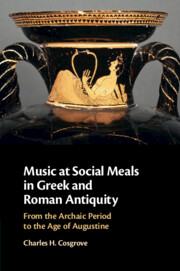Book contents
- Music at Social Meals in Greek and Roman Antiquity
- Music at Social Meals in Greek and Roman Antiquity
- Copyright page
- Dedication
- Contents
- Figures
- Glossary of Musical Instruments
- Abbreviations
- Introduction The Topic and the Sources
- Chapter 1 Sympotic Scenes and Songs
- Chapter 2 The Gentleman’s Lyre
- Chapter 3 Hellenistic Evolutions
- Chapter 4 Poets and Musicians at Upper-Class Greek Banquets
- Chapter 5 Music and Elite Dining in the Roman Age
- Chapter 6 Music at the Social Recreations of the Lower Classes
- Chapter 7 Music at the Suppers and Feasts of the Jewish People
- Chapter 8 Music at Christian Social Meals
- Chapter 9 Purposes and Pleasures
- Bibliography
- Index Locorum
- Subject Index
Chapter 3 - Hellenistic Evolutions
Published online by Cambridge University Press: 18 November 2022
- Music at Social Meals in Greek and Roman Antiquity
- Music at Social Meals in Greek and Roman Antiquity
- Copyright page
- Dedication
- Contents
- Figures
- Glossary of Musical Instruments
- Abbreviations
- Introduction The Topic and the Sources
- Chapter 1 Sympotic Scenes and Songs
- Chapter 2 The Gentleman’s Lyre
- Chapter 3 Hellenistic Evolutions
- Chapter 4 Poets and Musicians at Upper-Class Greek Banquets
- Chapter 5 Music and Elite Dining in the Roman Age
- Chapter 6 Music at the Social Recreations of the Lower Classes
- Chapter 7 Music at the Suppers and Feasts of the Jewish People
- Chapter 8 Music at Christian Social Meals
- Chapter 9 Purposes and Pleasures
- Bibliography
- Index Locorum
- Subject Index
Summary
Chapter 3 discusses the fading of music rituals at elite symposia, which was due in large part to the diminishing cultural significance of the musical arts in defining the aristocrat (a process that was already well underway by the fourth century), an increasing preference for professional entertainments, and the evolution of the upper-class domestic symposion itself. The last of these included the abandonment of rituals marking the transition from meal to symposion, the replacement of the communal wine krater with individualized wine service, and a shift to larger social meals, which new forms of dining architecture accommodated. The group paean and scolia disappeared very quickly. Other forms of organized music-making by dining groups continued in some places during the third century but were nearly obsolete by the middle of the second. It is likely that recital of poetry became at least as common or more common than singing it. In addition to describing these developments, the chapter gives special attention to stories about occasional singing and dancing by diners who engaged in those activities as self-display, performing for others.
Keywords
- Type
- Chapter
- Information
- Music at Social Meals in Greek and Roman AntiquityFrom the Archaic Period to the Age of Augustine, pp. 101 - 114Publisher: Cambridge University PressPrint publication year: 2022

